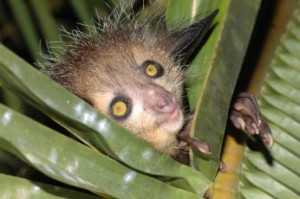Aye Aye or Finger Animal
The Aye Aye (Daubentonia Madagascariensis) is also called finger animal, these very rare and shy lemurs are by far the strangest lemurs you can see here on Madagascar.

Its food consists mainly of larvae which it takes out of fruits with its very long finger after it has located them for the first time by knocking and then biting its way through to the larvae with its teeth.
From an ecological standpoint, the aye-aye fills the niche of a woodpecker, as it is able to penetrate the wood to extract the invertebrates that live within.
The Aye-aye is the only extant member of the genus Daubentonia and the family Daubentoniidae. It is currently classified as endangered. A second species, Daubentonia robusta, appears to have become extinct sometime within the last 1000 years.
Its appearance would make some people shudder. Red eyes, dark fur, long fingers, big teeth... Behind this disturbing physique is the Aye-Aye, a lemur known to be the largest nocturnal primate in the world.
This animal has a length of 75 to 90 centimeters and can be observed at nightfall in the forests of Madagascar.
Behavior and lifestyle
The aye-aye is a nocturnal and arboreal animal, which means it spends most of its life high in the trees. Although they have been known to come down to the ground occasionally, they sleep, feed and mate in the trees and are most often found near the canopy where the dense foliage provides good cover.

The smaller territories of females often overlap those of at least a few males. Male aye-ayes tend to share their territories with other males and have even been known to share the same nests (though not at the same time), and can seemingly tolerate each other until they hear the call of a female looking for a mate.
Diet and foraging
Aye-aye is an omnivore and usually feeds on seeds, fruits, nectar and mushrooms, but also insect larvae and honey. The animal knocks on tree trunks and branches up to eight times per second, listening for the echo this creates to find cavities. Once a chamber is found, they chew a 
Although foraging is usually solitary, they occasionally forage in groups. Individual movements within the group are coordinated by both voices and scent signals.
Social behavior
The aye-aye is classically considered a solitary species, as they have not been observed to care for each other. However, recent research suggests that they are more social than previously thought. They usually stick to foraging in their own personal territory.
The home ranges of the males 
The males live in large territories , while the females have smaller living quarters. It is difficult for males to defend a single female because of the large range. Regular scent markings with their cheeks and neck alert others to their presence and repel intruders from their territory.
As with many other prosimians, the female aye-aye is dominant over the male. They are generally non-monogamous and often challenge each other for mates. Males are very assertive in this way and sometimes even pull other males away from a female during mating. Males are usually bonded to females during mating in sessions that can last up to an hour. Outside of mating, males and females interact only occasionally, usually while foraging. The aye-aye is believed to be the only primate that uses echolocation to find its prey.
Distribution and habitat
The Aye-Aye are nocturnal animals, they live mainly at the East coast Madagascar. Its natural habitat is rainforest or deciduous forest, but many live in cultivated areas due to deforestation. 
Nature Conservation
The aye-aye was thought to be extinct in 1933, but was rediscovered in 1957. Nine individuals were found in 1966 after Nosy Mangabe, an island near Maroantsetra in eastern Madagascar. Recent research shows that the Aye-Aye is more widespread than previously thought, but its conservation status was classified as Endangered in 2014.
There are three main reasons for this: The aye-aye is considered evil, Madagascar's forests are destroyed, and farmers kill the aye-aye to protect their crops and to poach. However, there is no direct evidence to suggest that the aye-aye pose a legitimate threat to crops and are therefore killed based on superstition.
Where can you watch Aye Aye?
As already written, fingered animals are rare and very shy and also active only at night. This, of course, limits the possibilities considerably but vacation in Madagascar can incorporate the observations of these animals in several tours:
- Andasibe and Sainte Marie where the fingered animals are brought to a small island at the Pangalan channel can be observed with absolute certainty.
- At the Extreme road to Maroantsetra you can find some in Mananara North observe
- When visiting Masoala, whether with Arol Lodge or with Masoala Forest Lodge, you can find some on the tiny Nosy Mangabe Island observe
Popular belief
Some of the Malagasy consider aye-ayes to be bad omens, although other legends consider them to be a good omen. If discovered, they are killed on sight and hanged so that the evil spirit is carried away by the travelers. Many Fady (Taboo) are associated with finger animals.
Others believe that if you point your slenderest finger at someone, they will be marked for death. Some say that the appearance of an aye-aye in a village predicts the death of a villager, and the only way to prevent this is to kill him.
The Sakalava go so far as to claim that Aye-Ayses sneak into homes through thatched roofs and murder sleeping residents by piercing the victim's aorta with their middle finger.
















